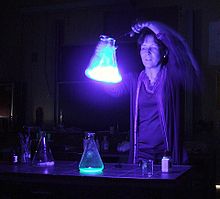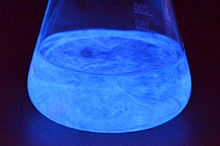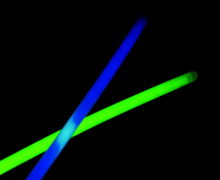
Chemiluminescence (also chemoluminescence) is the emission of light (luminescence) as the result of a chemical reaction, i.e. a chemical reaction results in a flash or glow of light. A standard example of chemiluminescence in the laboratory setting is the luminol test. Here, blood is indicated by luminescence upon contact with iron in hemoglobin. When chemiluminescence takes place in living organisms, the phenomenon is called bioluminescence. A light stick emits light by chemiluminescence.
Physical description
As in many chemical reactions, chemiluminescence starts with the combining of two compounds, say A and B, to give a product C. Unlike most chemical reactions, the product C converts to a further product, which is produced in an electronically excited state often indicated with an asterisk:
- A + B → C
- C → D*
D* then emits a photon (hν), to give the ground state of D: I
- D* → D + hν
In theory, one photon of light should be given off for each molecule of reactant. In practice, the yield ("quantum efficiency") is often low owing to side reactions.
For example, A could be luminol and B could be hydrogen peroxide. D would be 3-APA (3-aminophthalate).
Chemiluminescence differs from fluorescence or phosphorescence in that the electronic excited state is the product of a chemical reaction rather than of the absorption of a photon. It is the antithesis of a photochemical reaction, in which light is used to drive an endothermic chemical reaction. Here, light is generated from a chemically exothermic reaction. The chemiluminescence might be also induced by an electrochemical stimulus, in this case is called electrochemiluminescence.

Liquid-phase reactions
Chemiluminescence was first observed with lophine (triphenylimidazole). When in basic solution, this compound converts to the imidazolate, which reacts with oxygen to eventually give a dioxetane. Fragmentation of the dioxetane gives the excited state of an anionic diamide.

Chemiluminescence in aqueous system is mainly caused by redox reactions.

- Luminol in an alkaline solution with hydrogen peroxide in the presence of iron or copper, or an auxiliary oxidant, produces 3-aminophtalate in an excited state, which exhibits chemiluminescence. The luminol reaction is
Gas-phase reactions

- One of the oldest known chemiluminescent reactions is that of elemental white phosphorus oxidizing in moist air, producing a green glow. This is a gas-phase reaction of phosphorus vapor, above the solid, with oxygen producing excited states of (PO)2 and HPO.
- Another gas phase reaction is the basis of nitric oxide detection in commercial analytic instruments applied to environmental air-quality testing. Ozone (O3) is combined with nitric oxide (NO) to form nitrogen dioxide (NO2) in an activated state :
- The activated NO2[◊] luminesces broadband visible to infrared light as it reverts to a lower energy state. A photomultiplier and associated electronics counts the photons that are proportional to the amount of NO present. To determine the amount of nitrogen dioxide, NO2, in a sample (containing no NO) it must first be converted to nitric oxide, NO, by passing the sample through a converter before the above ozone activation reaction is applied. The ozone reaction produces a photon count proportional to NO that is proportional to NO2 before it was converted to NO. In the case of a mixed sample that contains both NO and NO2, the above reaction yields the amount of NO and NO2 combined in the air sample, assuming that the sample is passed through the converter. If the mixed sample is not passed through the converter, the ozone reaction produces activated NO2[◊] only in proportion to the NO in the sample. The NO2 in the sample is not activated by the ozone reaction. Though unactivated NO2 is present with the activated NO2[◊], photons are emitted only by the activated species that is proportional to original NO. Final step: Subtract NO from (NO + NO2) to yield NO2
Infrared chemiluminescence
In chemical kinetics, infrared chemiluminiscence (IRCL) refers to the emission of infrared photons from vibrationally excited product molecules immediately after their formation. The intensities of infrared emission lines from vibrationally excited molecules are used to measure the populations of vibrational states of product molecules.
The observation of IRCL was developed as a kinetic technique by John Polanyi, who used it to study the attractive or repulsive nature of the potential energy surface for gas-phase reactions. In general the IRCL is much more intense for reactions with an attractive surface, indicating that this type of surface leads to energy deposition in vibrational excitation. In contrast reactions with a repulsive potential energy surface lead to little IRCL, indicating that the energy is primarily deposited as translational energy.
Enhanced chemiluminescence
Enhanced chemiluminescence (ECL) is a common technique for a variety of detection assays in biology. A horseradish peroxidase enzyme (HRP) is tethered to an antibody that specifically recognizes the molecule of interest. This enzyme complex then catalyzes the conversion of the enhanced chemiluminescent substrate into a sensitized reagent in the vicinity of the molecule of interest, which on further oxidation by hydrogen peroxide, produces a triplet (excited) carbonyl, which emits light when it decays to the singlet carbonyl. Enhanced chemiluminescence allows detection of minute quantities of a biomolecule. Proteins can be detected down to femtomole quantities, well below the detection limit for most assay systems.
Applications
- Gas analysis: for determining small amounts of impurities or poisons in air. Other compounds can also be determined by this method (ozone, N-oxides, S-compounds). A typical example is NO determination with detection limits down to 1 ppb. Highly specialised chemiluminescence detectors have been used recently to determine concentrations as well as fluxes of NOx with detection limits as low as 5 ppt.
- Analysis of inorganic species in liquid phase
- Analysis of organic species: useful with enzymes, where the substrate is not directly involved in the chemiluminescence reaction, but the product is
- Detection and assay of biomolecules in systems such as ELISA and Western blots
- DNA sequencing using pyrosequencing
- Lighting objects. Chemiluminescence kites, emergency lighting, glow sticks (party decorations).
- Combustion analysis: Certain free radical species (such as CH and OH) give off radiation at specific wavelengths. The heat release rate is calculated by measuring the amount of light radiated from a flame at those wavelengths.
- Children's toys.
- Glow sticks.
Biological applications
Chemiluminescence has been applied by forensic scientists to solve crimes. In this case, they use luminol and hydrogen peroxide. The iron from the blood acts as a catalyst and reacts with the luminol and hydrogen peroxide to produce blue light for about 30 seconds. Because only a small amount of iron is required for chemiluminescence, trace amounts of blood are sufficient.
In biomedical research, the protein that gives fireflies their glow and its co-factor, luciferin, are used to produce red light through the consumption of ATP. This reaction is used in many applications, including the effectiveness of cancer drugs that choke off a tumor's blood supply. This form of bioluminescence imaging allows scientists to test drugs in the pre-clinical stages cheaply. Another protein, aequorin, found in certain jellyfish, produces blue light in the presence of calcium. It can be used in molecular biology to assess calcium levels in cells. What these biological reactions have in common is their use of adenosine triphosphate (ATP) as an energy source. Though the structure of the molecules that produce luminescence is different for each species, they are given the generic name of luciferin. Firefly luciferin can be oxidized to produce an excited complex. Once it falls back down to a ground state a photon is released. It is very similar to the reaction with luminol.
Many organisms have evolved to produce light in a range of colors. At the molecular level, the difference in color arises from the degree of conjugation of the molecule, when an electron drops down from the excited state to the ground state. Deep sea organisms have evolved to produce light to lure and catch prey, as camouflage, or to attract others. Some bacteria even use bioluminescence to communicate. The common colors for the light emitted by these animals are blue and green because they have shorter wavelengths than red and can transmit more easily in water.
In April 2020, researchers reported having genetically engineered plants glow much brighter than previously possible by inserting genes of the bioluminescent mushroom Neonothopanus nambi. The glow is self-sustained, works by converting plants' caffeic acid into luciferin and, unlike for bacterial bioluminescence genes used earlier, has a relatively high light output that is visible to the naked eye.
Chemiluminescence is different from fluorescence. Hence, fluorescent proteins such as Green fluorescent protein are not chemiluminescent. However, combining GFP with luciferases allows bioluminescence resonance energy transfer (BRET), which increases the quantum yield of light emitted in these systems.
See also
References
- Vacher, Morgane; Fdez. Galván, Ignacio; Ding, Bo-Wen; Schramm, Stefan; Berraud-Pache, Romain; Naumov, Panče; Ferré, Nicolas; Liu, Ya-Jun; Navizet, Isabelle; Roca-Sanjuán, Daniel; Baader, Wilhelm J.; Lindh, Roland (March 2018). "Chemi- and Bioluminescence of Cyclic Peroxides". Chemical Reviews. 118 (15): 6927–6974. doi:10.1021/acs.chemrev.7b00649. PMID 29493234.
- Radziszewski, B. R. (1877). "Untersuchungen über Hydrobenzamid, Amarin und Lophin". Berichte der Deutschen Chemischen Gesellschaft (in German). 10 (1): 70–75. doi:10.1002/cber.18770100122.
- Nakashima, Kenichiro (2003). "Lophine derivatives as versatile analytical tools". Biomedical Chromatography. 17 (2–3): 83–95. doi:10.1002/bmc.226. PMID 12717796.
- Shah, Syed Niaz Ali; Lin, Jin-Ming (2017). "Recent advances in chemiluminescence based on carbonaceous dots". Advances in Colloid and Interface Science. 241: 24–36. doi:10.1016/j.cis.2017.01.003. PMID 28139217.
- "Luminol chemistry laboratory demonstration". Retrieved 2006-03-29.
- "Investigating luminol" (PDF). Salters Advanced Chemistry. Archived from the original (PDF) on September 20, 2004. Retrieved 2006-03-29.
- Rauhut, Michael M. (1985), Chemiluminescence. In Grayson, Martin (Ed) (1985). Kirk-Othmer Concise Encyclopedia of Chemical Technology (3rd ed), pp 247 John Wiley and Sons. ISBN 0-471-51700-3
- Air Zoom | Glowing with Pride Archived 2014-06-12 at the Wayback Machine. Fannation.com. Retrieved on 2011-11-22.
- Atkins P. and de Paula J. Physical Chemistry (8th ed., W.H.Freeman 2006) p.886 ISBN 0-7167-8759-8
- Steinfeld J.I., Francisco J.S. and Hase W.L. Chemical Kinetics and Dynamics (2nd ed., Prentice-Hall 1998) p.263 ISBN 0-13-737123-3
- Atkins P. and de Paula J. p.889-890
- Enhanced CL review. Biocompare.com (2007-06-04). Retrieved on 2011-11-22.
- High Intensity HRP-Chemiluminescence ELISA Substrate Archived 2016-04-08 at the Wayback Machine. Haemoscan.com (2016-02-11). Retrieved on 2016-03-29.
- "Ecophysics CLD790SR2 NO/NO2 analyser" (PDF). Archived from the original (PDF) on 2016-03-04. Retrieved 2015-04-30.
- Stella, P., Kortner, M., Ammann, C., Foken, T., Meixner, F. X., and Trebs, I.: Measurements of nitrogen oxides and ozone fluxes by eddy covariance at a meadow: evidence for an internal leaf resistance to NO2, Biogeosciences, 10, 5997-6017, doi:10.5194/bg-10-5997-2013, 2013.
- Tsokankunku, Anywhere: Fluxes of the NO-O3-NO2 triad above a spruce forest canopy in south-eastern Germany. Bayreuth, 2014 . - XII, 184 P. ( Doctoral thesis, 2014, University of Bayreuth, Faculty of Biology, Chemistry and Earth Sciences)
- Kinn, John J "Chemiluminescent kite" U.S. patent 4,715,564issued 12/29/1987
- Kuntzleman, Thomas Scott; Rohrer, Kristen; Schultz, Emeric (2012-06-12). "The Chemistry of Lightsticks: Demonstrations To Illustrate Chemical Processes". Journal of Chemical Education. 89 (7): 910–916. Bibcode:2012JChEd..89..910K. doi:10.1021/ed200328d. ISSN 0021-9584.
- Chemiluminescence as a Combustion Diagnostic Archived 2011-03-02 at the Wayback Machine Venkata Nori and Jerry Seitzman - AIAA - 2008
- "Dokterfeest-Beste winkel van Nederland". Dokterfeest. 2 January 2025. Retrieved 2025-01-02.
{{cite web}}: CS1 maint: url-status (link) - "Sustainable light achieved in living plants". phys.org. Retrieved 18 May 2020.
- "Scientists use mushroom DNA to produce permanently-glowing plants". New Atlas. 28 April 2020. Retrieved 18 May 2020.
- "Scientists create glowing plants using mushroom genes". the Guardian. 27 April 2020. Retrieved 18 May 2020.
- Mitiouchkina, Tatiana; Mishin, Alexander S.; Somermeyer, Louisa Gonzalez; Markina, Nadezhda M.; Chepurnyh, Tatiana V.; Guglya, Elena B.; Karataeva, Tatiana A.; Palkina, Kseniia A.; Shakhova, Ekaterina S.; Fakhranurova, Liliia I.; Chekova, Sofia V.; Tsarkova, Aleksandra S.; Golubev, Yaroslav V.; Negrebetsky, Vadim V.; Dolgushin, Sergey A.; Shalaev, Pavel V.; Shlykov, Dmitry; Melnik, Olesya A.; Shipunova, Victoria O.; Deyev, Sergey M.; Bubyrev, Andrey I.; Pushin, Alexander S.; Choob, Vladimir V.; Dolgov, Sergey V.; Kondrashov, Fyodor A.; Yampolsky, Ilia V.; Sarkisyan, Karen S. (27 April 2020). "Plants with genetically encoded autoluminescence". Nature Biotechnology. 38 (8): 944–946. doi:10.1038/s41587-020-0500-9. ISSN 1546-1696. PMC 7610436. PMID 32341562. S2CID 216559981.
| Lighting | |||||||||||||
|---|---|---|---|---|---|---|---|---|---|---|---|---|---|
| Concepts | |||||||||||||
| Methods of generation |
| ||||||||||||
| Stationary | |||||||||||||
| Portable | |||||||||||||
| Automotive | |||||||||||||
| |||||||||||||
| |||||||||||||
| |||||||||||||
| Related topics | |||||||||||||


